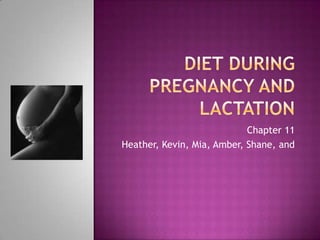
Diet suggestion during Pregnancy and Lactation
- 1. Chapter 11 Heather, Kevin, Mia, Amber, Shane, and
- 2. It is natural and necessary to gain weight during pregnancy. The mother’s uterus, breasts, placenta, blood volume, body fluids, and fat must all increase to accommodate the infant’s developing needs Average weight gain is 25-35 lbs. for normal woman A pregnant teen who is still developing will gain more weight than a mature woman, whereas an obese women is likely to gain less but no less than 15 lbs.
- 3. Protein requirement is increase by 20-25% (iron, zinc, copper, and B vitamins) No need for increased Vitamin A, excessive intake can cause birth defects All water soluble vitamins (D, E, K, and C) should be increased Minerals such as calcium iron, zinc, iodine, and selenium are are essential for functions such as development of the infants bones and teeth as well as blood clotting and muscle action Drinking additional milk each day is a good way of providing these nutrients Vitamin/ iron supplements may be prescribed by an obstetrician, nurse, midwife, or physicians assistant (PA)
- 4. Nausea- occurs during the first trimester, also known as “morning sickness”, but not necessarily felt just in the mornings Hyperemesis Gravidarum- rare condition that nausea becomes so sever it is life threatening Constipation- can be relieved by eating high-fiber foods, daily exercise, and/or drinking 8 glasses of water each day Heartburn- common, seeing as the growing fetus pushes on the mother’s stomach, which may cause stomach acid to move into lower esophagus Weight Gain
- 5. Pregnancy Induced Hypertension (PIH)- also known as toxemia or preeclampsia. A condition that occurs in the third trimester and is characterized by high blood pressure, the precise of albumin in urine, and edema. The causes are unknown but occur more frequently to pregnant women with inadequate diets Pica- craving of nonfood substances such as starch, clay (soil), or ice. Although both men and women are infected with pica, its more common with pregnant woman. Some believe it relieves nausea but this should be discourages because it can cause colon blockage and create nutritional deficiencies Anemia-condition caused by insufficient red blood cells, hemoglobin, or blood volume. Patient doesn’t receive enough oxygen from blood, feeling weak/tired, poor appetite, and appears pale.
- 6. Alcohol, Caffeine, Drugs, and Tobacco Alcohol Consumption can lead to FAS (Fetal alcohol syndrome), which can cause infants to be premature, have a low birth weight, physical characteristics, as well as other central nervous system dysfunction Caffeine is known to cross placenta and enter fetal blood stream Drugs vary in their effects but can cause fetal malformations and spontaneous absorptions, possibly even HIV Tobacco smoking is associated with babies of reduced birth weight because smoking reduces the oxygen/nutrients carried by the blood.
- 7. Diet should remain about the same as normal pregnant women Should maintain their blood glucose at a steady level between meals Either type of diabetes increase the risk of physical or mental diabetes
- 8. This as become an increasing concern Nutritional, physical, psycholigol, social, and economic demands are tremendous leaving young mothers responsible for helpless newborns Adolescents are particularly vulnerable to PIH (Pregnancy Induced Hypertension) and premature delivery Inadequate nutrition of a mother is related to both mental and physical birth defects Pregnant teen need much counseling and emotional support before nutritional improvements can be suggested
- 9. It is the production and secretion of breast milk for the purpose of nourishing an infant, that is facilitated by an interlay do various hormones after delivery of an infant Will take 2-3 weeks to establish a feeding routine Supply-and-demand mechanism, mother will produce when infant wants Approximately 85 kcal is required to produce 100 Ml of milk (3 1/3 oz.) Extra nutrients are required such as fruits, vegetables, and vitamins and an extra 640 kcal a day
- 10. Breast milk contains the right amount of lactose, water, fatty acids, and amino acids for brain development, growth, and digestion Breast fed babies have incidences of ear infections, diarrhea, allergies, ad hospital admissions Receive antibodies to diseases such as pneumonia, bronchitis, influenza, German measles, botulism, and staphylococcal infections Sucking at the breast promotes good jaw development/ exercise Nursing may have psychological benefits for the infant by creating an early emotional attachment between mother and child
